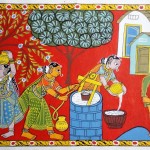
Part of what makes a culture hum is its high principles and high art and part of it is the folk art and artisanship of the masses. Ancient and Medieval Andhra desa originated and perfected many such crafts from the people-at-large. One such is native to India’s twenty ninth state, and the city of the Grand Kakatiyas: Pembarthi Metalcraft.
Pembarthi village in Warangal District of Telangana is the home of a particular and beautiful style of sheetmetal workmanship. It is located 65km away from the medieval capital of the Telugus, and is a tree-lined and industrious agglomeration of skilled craftspeople with a famous pedigree: Vishwakarma.
History
Pembarthi metal craft as a distinct brand dates back to the Kakatiya era. This mighty kingdom of Ganapati, Rudramba, and Prataparudra, was an empire of not only diamonds and metalwork, but temples as well.
From Svayambunatha and Veyi Sthambhala to Ramappa and Ghanpur, the Royals of Warangal were great builders of Devalayas, and with that, came demand for craftsmen from all parts of India. Though Varanasi was a great centre of metal work in brass and panchaloha, Pembarthi soon rose to rival it in this department. With the attraction and confluence of talent from various corners of Bharat, a distinct style and craft was created.
The Vishwakarmas are credited with origination and mastery of this process. Members of this community preserve and propagate this handicraft to this day.
Characteristics

Although it is primarily known for its high skill and detail in brassware, Pembarthi extends to the Pancha loha, or 5 traditional metals of Gold, Silver, Copper, Iron, and Brass (which are frequently combined). In fact, silver coating is most commonly used for decorative items, particularly for temples.
This craft adorns the vigrahas (statues) and vahanas (chariots) in temples. However, it is very frequently found in the form of detailed brass kumbhas.


Scenes from the Puranas are commonly featured on Pembarthi Brass artwork. Flower pots, vases, drinking cups, and even chairs have been fashioned from this native process of Telangana. It has even been applied to the forging of decorative swords such as this one.

However, the trademark design and motif of choice remains the distinctive Pembarthi peacock, featured above. It is a favourite among local and foreign buyers. Swans are also common models for this product as well.
Process

Pembarthi artisans use the ancient art of wax casting to prepare the manufacture of these fine pieces.
A fine sheet of brass, or other metal, is first selected by the worker. Designs are then drawn on paper to pre-determine the nature of the piece and specific motifs that will be utilised. Lac (lakka) or ancient Indian wax-casting is then used to prepare the molding of the fine ware. Fine chisels are then used to engrave intricate detail. The basic feature is then embossed on the sheet. Gas torch burners are used to weld separate pieces together.

Assorted workshops then handcraft the metal, pounding the design to perfection.

The item is washed with acid and tamarind water, then polished and prepared for sale. While wax preparation takes about 4 hours, to produce a finished piece takes 4 days.
Future

Pembarthi metalwork is an ancient art now finding modern popularity. Having received distinctive Geographic Indicator status, it is a brand of its own. In fact, Pembarthi metal work can even be found in Manhattan hotels and Tokyo Office lobbies, such is its international appeal.
Used for a variety of decorative and domestic purposes, it is an ideal addition to any home, office, or even temple. From illustrated panels to decorative chairs and vessels, from The Dashavatar to Ashtalakshmi and even the Kakatiya Torana, a variety of purposes and motifs are used for this metal craft. Driven jointly by the men and women of the Vishwakarma community, it is truly a living tradition of the people. Faced with low prices, high debt, and youth leaving the village, preservers of this beautiful handicraft themselves are in need of preservation.
Over 60 families are estimated to be dedicated to maintaining and passing on this ancient craft. The village of Pembarthi itself is said to be 5,000 years old according to folklore, and this tradition, which attained its pinnacle under the Kakatiyas should be given patronage by today’s “nouveau elite” and passed on to the next generation.
Thus, Pembarthi is one of the beautiful handicrafts and great gifts of the people of Telangana to the common heritage of the Telugus.
References:
- http://lepakshihandicrafts.gov.in/brassart.html
- http://www.warangalonline.in/city-guide/pembarti-village-of-warangal
- http://www.dsource.in/resource/sheet-metal-embossing/making_process/index.html
- http://www.india-crafts.com/metal_work/brassware/index.html
- http://www.academia.edu/5864971/ENVIRONMENTAL_FRIENDLINESS_IN_MANUFACTURING_OF_TRADITIONAL_HANDICRAFTS_A_NEW_PERSPECTIVE
- http://www.craftrevival.org/voiceDetails.asp?Code=219
- http://www.ipindia.nic.in/girindia/journal/Journal_35.pdf





